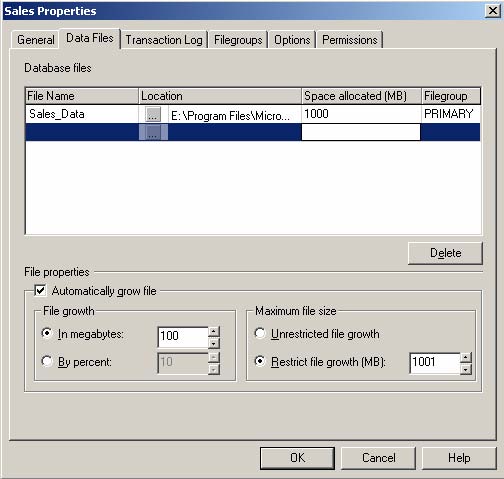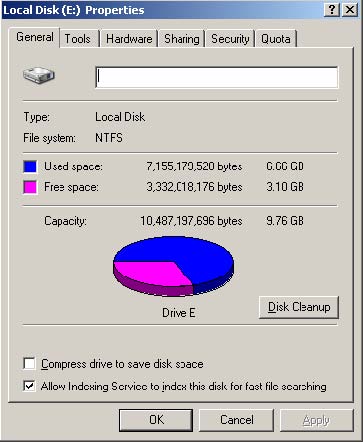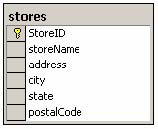You are the administrator of a SQL Server 2000 computer in your company's personnel department. Employee data is stored in a SQL Server 2000 database. A portion of the database schema is shown in the exhibit.

You want to create a text file that lists these data columns in the following format title, FirstName, LastName, WorkPhone, PositionName, DepartmentName.
You want to create the text file as quickly as possible. You do not expect to re-create this file, and you want to avoid creating new database objects if possible.
What should you do?
A.Use the bcp utility to export data from each table to a separate text file. Use format files to select the appropriate columns. Merge the data from each text file into a single text file.
B.Create a view that joins data from all three tables include only the columns you want to appear in the text file. Use the bcp utility to export data from the view.
C.Create a SELECT query that joins the data from the appropriate columns in the three tables. Add an INTO clause to the query to create a local temporary table. Use the bcp utility to export data from the local temporary table to a text file.
D.Create a SELECT query that joins the data from the appropriate columns in the three tables. Add an INTO clause to the query to create a global temporary table. Use the bcp utility to export data from the global temporary table to a text file.
第1题:
You are the database administrator of a SQL Server 2000 computer. The server contains your company's Accounts database. Hundreds of users access the database each day.
Because you have had power interruptions in the past, you want to perfect the physical integrity of the Accounts database. You do not want to slow down server operations.
What should you do?
A.Enable the torn page detection database option for each database.
B.Disable write caching on all disk controllers.
C.Ensure that write caching disk controllers have battery backups.
D.Create a database maintenance plan to check database integrity and make repairs each night.
第2题:
You are the administrator of a SQL server computer. The server is running SQL Server 6.5 and SQL Server 7.0.
You install a named instance of SQL Server 2000, and then run the SQL server upgrade wizard. On the database selection screen, some of the SQL Server 6.5 databases are not listed.
You cancel the SQL Server upgrade wizard.
You need to ensure that the SQL Server 6.5 databases are listed in the wizard. What should you do?
A.Uninstall SQL Server 7.0, and then rerun the SQL Server upgrade wizard.
B.Run the Microsoft SQL Server-switch application, and then rerun the SQL Server upgrade wizard.
C.Create a data transformation services package that imports the databases from SQL Server 6.5 to SQL Server 2000, and then execute the package.
D.Uninstall SQL Server 2000, and then reinstall SQL Server 2000 as the default instance.
第3题:
You are a database administrator in the Los Angeles branch office of a specialty foods supplier. A mainframe. database at the headquarters contains all company data. Each branch office contains a SQL Server 2000 computer that imports regional data from the mainframe. database.
The server in Los Angeles contains a Data Transformation Services (DTS) package that uses OLE DB to connect to the company's mainframe. database. The DTS package extracts and transforms data about buyers and products for that region. The DTS package then writes the data to the SQL Server database in Los Angeles.
You need to configure a SQL Server computer for the new branch office in Sydney. You want to copy the Los Angeles package and modify it so that it writes data to the SQL Server database in Sydney.
You use the DTS Designer to modify the DTS package so that it imports regional data from the mainframe. database to the server in Sydney. The modified DTS package runs successfully on the server in Los Angeles. You save this DTS package to the server in Sydney, but the server in Sydney cannot connect to the mainframe. database.
You want to enable the server in Sydney to connect to the mainframe. database. What should you do?
A.Change the connection properties in the DTS package so that the package uses new login credentials to connect to the mainframe. database.
B.Modify the workflow in the DTS package so that the server in Sydney is included.
C.On the server in Sydney, install an OLE DB provider for the mainframe. database.
D.On the server in Sydney, delete and then re-create the DTS package.
第4题:
You are the administrator of a SQL Server 2000 computer. The server contains database named Sales. Users report that they cannot add new data to the database. You examine the properties of the database. The database is configured as shown in the Sales Properties exhibit.

You examine drive E. The hard disk is configured as shown in the Local Disk Properties exhibit.

You want the users to be able to add data, and you want to minimize administrative overhead. What should you do?
A.Increase the maximum file size of Sales_Data to 1,500MB.
B.Use the DBCC SHRINKDATABASE statement.
C.Set automatic file growth to 10 percent.
D.Create another data file named Sales_Data2 in a new SECONDARY filegroup.
第5题:
You are the administrator of a SQL Server 2000 computer. You create a Data Transformation Services (DTS) package. The package is stored as a local package on the server. The package exports data from an online transaction processing (OLTP) database system to an online analytical processing (OLAP) database system that is located on a second SQL Server 2000 computer.
You want the package to execute automatically each evening at 8:00 P.M. What should you do?
A.Use SQL Server Enterprise Manager to create a new job Create a CmdExec job step that runs the dtsrun utility Schedule the job to run each night at 8:00 P.M.
B.Use SQL Server Enterprise Manager to create a new job Create a Transact-SQL job step to query data from the OLTP database Create a second Transact-SQL job step to launch the DTS package Schedule the job to run each night at 8:00 P.M.
C.Create a batch file that runs the dtsrun utility Use the Microsoft Windows Task Scheduler to run the job each night at 8:00 P.M. Configure the Windows Task Scheduler to use the local system account
D.Move the DTS package to the repository Configure the SQLServerAgent service on the OLAP database server to update the package each night at 8:00 P.M.
第6题:
You are the administrator of two Microsoft Windows 2000 computers. One computer is running Internet Information Services (IIS), and the other is running SQL Server 2000. Company partners need to connect by means of the Internet and query data stored on the SQL Server computer. Some of these partners have computers that do not use Microsoft operating systems or Web browsers.
You need to configure the IIS and SQL Server 2000 computers to allow access to data by means of the IIS virtual directory. IIS uses Basic Authentication to allow access to the virtual directory.
Only company partners should have access to the SQL Server computer by means of the Internet. The partners should not be allowed to make ad hoc queries. You want to be able to audit successful and failed logins to the SQL Server computer.
You want to allow the partners access to the SQL Server computer while keeping your security scheme as simple as possible. Which two actions should you take? (Each correct answer represents part of the solution. Choose two.)
A.Configure the IIS virtual directory to allow URL queries.
B.Configure the IIS virtual directory to allow template queries.
C.Create a new Windows user account. Create a corresponding Windows Authenticated login on the SQL Server computer. Configure the IIS virtual directory to always use this login when connecting to the SQL Server computer.
D.Create a Windows Authenticated login on the SQL Server computer for the IIS Internet Guest Account. Configure the IIS virtual directory to always use the Internet Guest Account when connecting to the SQL Server computer.
E.Create a Windows Authenticated login for each company partner on the SQL Server computer. Configure the IIS virtual directory to use Windows Integrated Authentication when connecting to the SQL Server computer.
第7题:
You are the administrator of a SQL Server 2000 computer. You are creating a data transformation services package. As the first step in this process, you need to load data from text files into a database table. These text files contain data on new stores that join your franchise. The text files list the data columns in the following format StoreID, StoreName, Address, City, State, PostalCode, ManagerID, StoreTypeID, FacilityID.
The destination table is configured as shown in the exhibit.

You want to load the data into the table as quickly as possible. What should you do?
A.Use a Bulk Insert Task to read the data into a temporary table. Use an Execute SQL task to import the appropriate data into the destination table.
B.Create and edit a format file to select the columns you want to import. Use a Bulk Insert Task, and then specify the format file to import the appropriate data into the destination table.
C.Use a transform. data task to import the data. Use Microsoft ActiveX transformation scripts to write the appropriate data to the appropriate columns in the destination table.
D.Create and edit a format file to select the columns you want to import. Use a transform. data task, and then specify the format file to import the appropriate data into the destination table.
第8题:
You are the administrator of a SQL Server 2000 database. You import a table of geographic information from a Microsoft access database into a SQL Server 2000 database. The table has 12,000 rows. Each row averages 5,000 bytes. The table contains lockup data that does not change.
You want to minimize the size of the data file and the time required to back up the data. Which two actions should you take? (Each correct answer presents part of the solution. Choose two)
A. Create a 60-MB data file named geography.ndf
B. Create a 95-MB data file named geography.ndf
C. Create a 60-MB data file named geography.mdf
D. Create a 95-MB data file named geography.mdf
E. Place the table in the PRIMARY filegroup.
F. Place the table in a new filegroup named LOCATION.
第9题:
You are the administrator of a SQL Server 2000 computer. Your company uses the server to store service contract information for its customers.
You are also the administrator of Oracle relational database management system (RDBMS) server.
This server is used to store your company’s financial information. The financial information is updated frequently throughout the day.
You need to create a series of reports that combine the service contract information and the financial information. These reports will be updated several times a day.
You want to create reports on the SQL Server computer by using the minimum amount of disk space.
What should you do?
A.Set up SQL server replication to replicate the data from the oracle server to the SQL server computer.
B.Set up the oracle server as a linked server. Create a view that joins the service contract information and the financial information.
C.Set up data transformation services (DTS) package that imports and transforms the database from the oracle server to the SQL server computer. Use SQL server agent to execute the DTS package throughout the day as needed.
D.Set up Microsoft ActiveX script. that connects to the oracle server and imports the financial information into SQL server temporary table. Create a view that joins the service contract information and the temporary table.
第10题:
You are the administrator of a SQL Server 2000 computer. The server contains your company's order processing database. Two-hundred operators take orders by telephone 24 hours a day. Threehundred data entry personnel enter data from orders received by mail.
To ensure that order data will not be lost, your company's disaster recovery policy requires that backups be written to tape. Copies of these tapes must be stored at an off-site company location. Orders must be entered into the database before they can be filled. If the server fails, you must be able to recover the order data as quickly as possible.
You need to create a backup strategy that meets the company requirements and minimizes server workload. Which two actions should you take? (Each correct answer represents part of the solution. Choose two.)
A.Perform. a combination of full database and filegroup backups.
B.Perform. a combination of full database and file backups.
C.Perform. a combination of full database, differential, and transaction log backups.
D.Back up the data to a local tape drive.
E.Back up the data to a network share, and then use enterprise backup software to write the disk backups to tape.